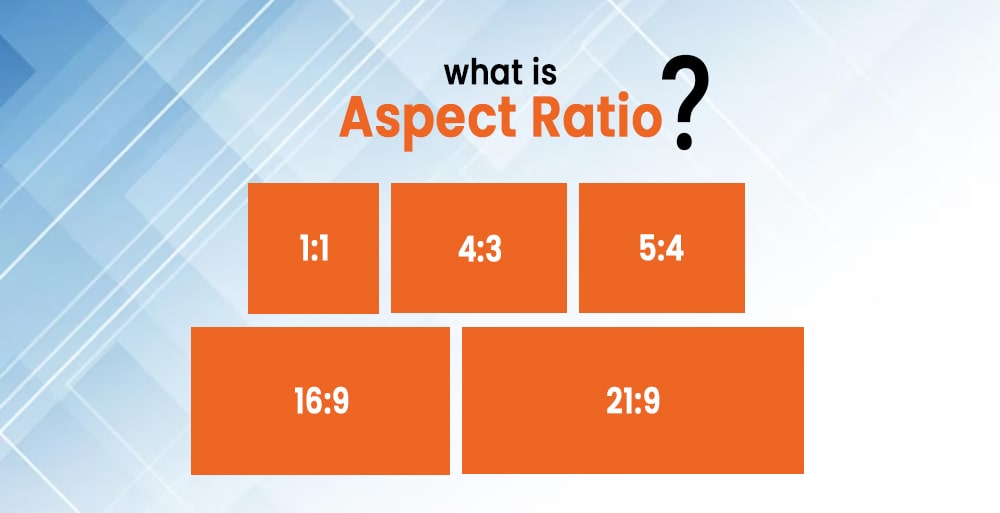
When you look at screens, such as those on your phone, tablet, laptop, or TV, you’ll notice they have different shapes. The aspect ratio determines the screen’s shape by comparing its width to its height. In this article, we’ll explore the significance of aspect ratio and how it impacts our screen viewing experience.
What is Aspect Ratio?
Aspect ratio is a way of saying how wide or tall a screen is. It’s like comparing the width and height of a screen. We write it as a special kind of number, like 16:9. The first number tells you how wide the screen is, and the second number tells you how tall the screen is. So if a screen has an aspect ratio of 16:9, that means it’s 16 units wide and 9 units tall. The two most common aspect ratios are 16:9, also known as 1.78:1 or wide screen, and 4:3 , also known as 1.33:1 or full screen .
Common Aspect Ratios:
Let’s explore some common aspect ratios that you can find on screens! Here are a few examples:
• 16:9 (Widescreen): This one is used a lot in TVs, computer screens, and modern devices. It’s wider and great for watching movies and videos.

• 4:3 (Standard): This aspect ratio was more common in older TVs and computer screens. It has a squarer shape and is good for things like presentations or older video games.

• 21:9 (Ultra-Wide): This aspect ratio is even wider and gives you a big view. It’s popular for gaming and makes movies feel more immersive.

• 1:1 (Square): This aspect ratio is all about equal width and height. You can find it on social media and photo apps, where pictures are often in a square shape.

So, different screens have different aspect ratios, and each one is good for different things!
The Significance of Aspect Ratio:
Aspect ratio is really important because it affects how everything looks on a screen. It’s like choosing the right frame for a picture. The aspect ratio can make a big difference in how images, videos, and text appear on the screen, and it can make the whole experience better. When you pick the right aspect ratio, it makes things look their best and shows the content exactly how it’s supposed to be seen. So, aspect ratio helps make everything on the screen look great and gives you the best experience possible!
Impact on Content Consumption
The aspect ratio of a screen can have a big impact on how we enjoy different kinds of content. Let me explain with examples!
Suppose you’re watching a movie on a screen with a wider aspect ratio like 16:9. It’s perfect for movies because it fills up your field of vision and gives you a cinematic experience. You won’t see those black bars at the top and bottom of the screen, called letterboxing, that you might see on screens with different aspect ratios.
Now, let’s say you’re reading a document or browsing the web. In this case, a narrower aspect ratio like 4:3 can be helpful. It gives you more vertical space to work with, which means you can see more of the page without scrolling too much. It’s like having a taller space to read and navigate comfortably.
So, depending on the content you’re consuming, different aspect ratios can make a big difference in how you enjoy and interact with it. It’s like having the right tool for the right job!
Aspect Ratios in Different Devices:
Let’s look at how aspect ratios vary across different devices:
Smartphones: Many smartphones now have taller aspect ratios like 18:9 or 19:9. This is because they want to make use of the entire front surface for the display, giving you more screen space for scrolling and vertical content like social media feeds.
Tablets: Tablets often have wider aspect ratios like 4:3 or 16:10. These ratios are great for consuming multimedia content like movies and browsing the web. They provide a wider viewing area, giving you a more immersive experience.
Televisions: Most modern TVs come with a 16:9 aspect ratio. This ratio is perfect for high-definition content, like watching movies or playing video games. It fills up your field of view and gives you that cinematic feel.
Computer Monitors: Computer monitors can have various aspect ratios depending on their purpose. Widescreen monitors with 16:9 or 21:9 ratios are popular for gaming and multimedia. They provide a wide viewing area, great for immersive experiences. On the other hand, professionals may prefer displays with 16:10 or 4:3 ratios for design work or programming. These ratios offer more vertical space, which is helpful for working with documents or code.
So, different devices have different aspect ratios tailored to their specific uses and the kind of content you want to enjoy or work with on them.
Choosing the Right Aspect Ratio and Future
Picking the right aspect ratio for your screen or display is crucial, and it depends on what you plan to do with it. Consider the purpose and the kind of content you’ll be using or creating. This will help ensure that you have a more immersive and enjoyable experience.
Looking ahead, as technology continues to advance, we might see new aspect ratios emerge to meet the changing needs of consumers. For example, with the growing popularity of virtual reality (VR) and augmented reality (AR), screens with wider aspect ratios could become more common. These wider ratios would enhance the immersive nature of these experiences, making them even more exciting and realistic.
So, keep an eye out for new aspect ratios in the future as technology progresses, and they may bring new possibilities for exciting and immersive content consumption!
To calculate the aspect ratio, you must find the ratio of the width to the height of an object or an image. Aspect ratio is usually expressed as two colon-separated numbers, like 16:9 or 4:3. To calculate the aspect ratio from the width and the height, follow the steps below:
How to calculate the aspect ratio from width and height?
Step 1: Obtain the width and height values of the object or image.
Step 2: Divide the width by the height.
Aspect Ratio = Width / Height
Step 3: Simplify the ratio if necessary. If the resulting ratio is not in its simplest form, divide both the width and height by their greatest common divisor (GCD) to simplify it.
Here’s an example to illustrate the calculation:
Let’s say we have an image with a width of 1200 pixels and a height of 800 pixels.
Step 1: Width = 1200, Height = 800
Step 2: Calculate the ratio:
Aspect Ratio = Width / Height
= 1200 / 800 = 1.5
Step 3: Simplify the ratio. In this case, the ratio is already in its simplest form (1.5 cannot be further simplified).Therefore, the aspect ratio of the image is 1.5:1.
Note: Sometimes the aspect ratio can be expressed as a number rather than a percentage, as in the example above. However, aspect ratios are usually simplified to whole numbers when they are used to describe screen resolutions or image sizes. You can use the Aspect Ratio Calculator to calculate the aspect ratio of your screen.
Conclusion
Aspect ratio has a significant impact on our daily interactions with screens. When we grasp the concept and recognize its implications, we can make smarter choices when choosing devices and have the best possible content consumption experience.
Whether we’re watching a movie on a widescreen TV or browsing the web on a smartphone, the aspect ratio of the screen shapes our digital experiences. It determines how content is displayed, how immersive it feels, and how visually pleasing it is. By understanding aspect ratio, we can appreciate how it enhances our visual delight and ensures that we make the most out of our digital interactions.
So, next time you’re selecting a device or enjoying content on a screen, keep in mind the importance of aspect ratio and how it contributes to your overall viewing pleasure!




